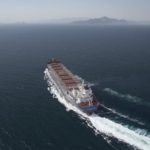Dry Bulk Grain flows from the U.S & Brazil: Brazilian grain exports broke records this year, outpacing weak US exports

As we enter the fourth quarter of this year, the market is showing a strong resurgence with rates increasing year-over-year. Notably, Capesize Brazil to North China rates have exceeded $20 per tonne. This significant upswing in the freight market’s momentum is evident not only in the large vessel size segment but also in the Supramax and Handysize categories.
This recent surge in rates has coincided with the initial signs of a manufacturing activity rebound in China during the annual Golden Week. According to the National Bureau of Statistics, China’s official Manufacturing Purchasing Managers’ Index (PMI) rose to 50.2 from 49.7 in August, indicating expansion for the first time since March. A PMI reading above 50 indicates growth or expansion, while anything below indicates contraction. Moreover, there was an acceleration in activity in the services and construction sectors last month, as evidenced by a separate index that reached 51.7, reflecting its strongest performance in three
months.
Brazilian grain exporters are experiencing a significant increase in shipments to different countries, while the United States is facing challenges in exporting due to the unfavorable harvest season. This year’s Brazilian grain exports have surpassed the levels witnessed in previous years, and the uncertainty around Ukraine’s grain exports has further fueled the demand. The disrupted Black Sea deal on July 17 has added to this uncertainty.
SECTION 1/ FREIGHT
‘The Big Picture’ – Capesize and Panamax Bulkers and Smaller Ship Sizes
Market Rates ($/t) Firmer
The first week of October began with significant increases in rates, indicating that the lows witnessed six weeks ago are firmly in the past. Notably, Capesize rates for Brazil to North China have now exceeded the $20 per tonne threshold.
Capesize vessel freight rates from Brazil to North China rose to almost $21/ton, marking a 4% weekly increase and 23% monthly gain.
Panamax vessel freight rates from the Continent to the Far East have remained stable and have now crossed $40 per tonne. This is the first time in weeks that we’ve seen a weekly gain. Currently, rates have increased by 7.4% on a monthly basis.
Supramax vessel freight rates on the Indo-ECI route fell by 3% to $13 per tonne on a weekly basis, but there was a significant monthly increase of 19% compared to the same week in October.
Handysize freight rates for the NOPAC Far East route rose to $31/tonne, up 5% from a month ago.
SECTION 2/ SUPPLY
Supply Trend Lines for Key Load Areas
Ballasters (# vessels) Decreasing
The number of ballast ships has decreased since September, particularly in the Capesize and Panamax segments, while increasing for Handysize vessels.
Capesize SE Africa: The number of ballasters dropped to 76, which is 32 vessels less than two weeks ago and 15 below the annual average.
Panamax SE Africa: The number of ballasts showed initial signs of dropping, approaching the annual average of 120. There is a tendency for a further decrease compared to the peak in week 34, which has lasted for almost five consecutive weeks.
Supramax SE Asia: The number of ballast ships neared to the annual average of 100, 17 less than the previous week.
Handysize NOPAC: The number of ballast ships rose to 85, but it remains to be seen whether there will be a sustained increase to the level of previous peaks above the threshold of 90.
SECTION 3/ DEMAND
Summary of Dry Bulk Demand, per Ship Size
Tonne Days Mixed
The first signs of recovery in the Capesize segment at the end of September continued and the growth rate was higher than three weeks ago, while the Panamax segment continues to see a downward correction.
Capesize: Demand growth in tons per day has accelerated since last week, fueling optimism for a freight rate recovery.
Panamax: The growth rate has been stable for the past month without any indication of an upturn in the near future.
Supramax: The decline of the previous weeks continued in October, with the growth rate now at its lowest since the end of week 37.
Handysize: The growth rates sharply declined after week 37, leaving uncertainty for October.
SECTION 4/ PORT CONGESTION
Dry Bulk Ships Congested at Chinese Ports
No of Vessels Steady
The level of ship congestion has remained steady over the past two weeks, with all sizes showing signs of increase except for Supramax.
Capesize: The number of congested vessels has increased by 7 from the previous week to 101, the same level as week 36, although it remains to be seen whether the number of congested vessels will continue to exceed 100.
Panamax: The number of congested ships has risen above 180, while it is still below 200 since week 35.
Supramax: The number of ships experiencing congestion has remained steady at around 250 since last week, despite indications of a potential increase to approximately 280 by the end of September.
Handysize: The number of congested ships stood 190 from a low of 167 in week 34.
Source: By Maria Bertzeletou, Signal Group, https://go.signalocean.com/e/983831/Account-Login/2pfr5j/350411274?h=uId4K5jyOgicD1CNZq2hki0a61sxeYapbLLjt4HpvL4
